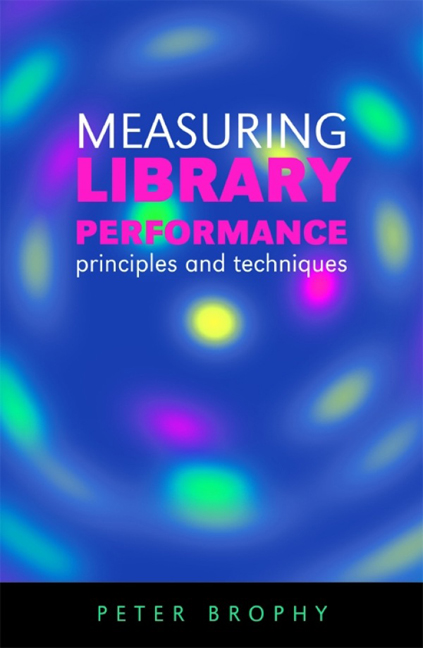Book contents
- Frontmatter
- Contents
- List of figures
- List of tables
- Preface
- Acronyms and abbreviations
- 1 Background
- 2 Theoretical considerations
- 3 User satisfaction
- 4 Impact on users
- 5 Social and economic impact
- 6 Inputs
- 7 Processes
- 8 Outputs
- 9 Staff
- 10 Infrastructure
- 11 Services for all
- 12 Benchmarking
- 13 The balanced scorecard
- 14 Standards
- Appendix 1 Data collection methods
- Appendix 2 The analysis of data
- Appendix 3 The presentation of results
- Index
- Frontmatter
- Contents
- List of figures
- List of tables
- Preface
- Acronyms and abbreviations
- 1 Background
- 2 Theoretical considerations
- 3 User satisfaction
- 4 Impact on users
- 5 Social and economic impact
- 6 Inputs
- 7 Processes
- 8 Outputs
- 9 Staff
- 10 Infrastructure
- 11 Services for all
- 12 Benchmarking
- 13 The balanced scorecard
- 14 Standards
- Appendix 1 Data collection methods
- Appendix 2 The analysis of data
- Appendix 3 The presentation of results
- Index
Summary
■ Introduction
Libraries, as do many other organizations, often state that their staff are their most valuable asset. If this is to be more than a platitude then it is important that they too form part of the performance measurement processes of the library. Such assessment must be undertaken with the utmost sensitivity and it is important that staff do not feel that they are on trial. Indeed, it is almost always the case that if staff are not performing to expectations then lack of training and/or lack of leadership are to blame rather than incompetence. Any action to evaluate staff performance should be undertaken with this in mind.
Measuring the effects of investment in staff, including training, is never easy because there are so many variables in play. As Oldroyd (1995) noted:
it is usually simple to measure the time taken up by training, but extremely difficult to measure its benefit. It becomes progressively more difficult the further one moves from tasks towards responsibilities. Some benefit is selfevident and shows itself in improved competence (particularly in a crisis), positive feedback from customers and good working relations. Other visible benefits are seen in high motivation, openness to change, trust and flexibility. A library with high morale, a good reputation among its users, and a good ‘feel’ can be an important factor in successful outcomes.
■ Staff surveys
One starting point for the assessment of staff performance is to begin with the staff themselves and undertake a staff satisfaction survey. It is surprising how infrequently this is done given the prevalence of user satisfaction surveys. Many of the principles discussed in Chapter 3, ‘User satisfaction’, are relevant to this kind of survey. In addition, there are sensitivities to observe and it is wise to gain institutional approval (you may be setting a precedent for other departments!) and to ensure that staff members, where appropriate including union representatives, are fully engaged with the process. This means, among other things, that data produced from such surveys should always be confidential and almost always anonymous.
The results of a staff satisfaction survey can be used to highlight issues of which senior managers may either be unaware or whose significance to their staff they may not realize.
- Type
- Chapter
- Information
- Measuring Library Performanceprinciples and techniques, pp. 122 - 128Publisher: FacetPrint publication year: 2006



